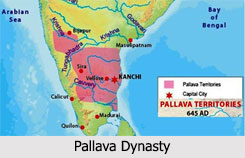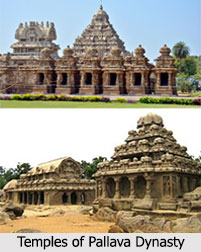 Pallava Dynasty was a famous power in South India that existed between the 3rd and 9th Centuries. They ruled northern parts of Tamil Nadu, parts of Karnataka, Andhra Pradesh and Telangana with Kanchipuram as their capital. The Pallavas supported Buddhism, Jainism, and the Brahminical faith and were patrons of music, painting and literature. Mahendravarman I was a great patron of art and architecture and is known for introducing a new style to Dravidian architecture.
Pallava Dynasty was a famous power in South India that existed between the 3rd and 9th Centuries. They ruled northern parts of Tamil Nadu, parts of Karnataka, Andhra Pradesh and Telangana with Kanchipuram as their capital. The Pallavas supported Buddhism, Jainism, and the Brahminical faith and were patrons of music, painting and literature. Mahendravarman I was a great patron of art and architecture and is known for introducing a new style to Dravidian architecture.
Origin of Pallava Dynasty
Pallava Dynasty was earlier feudatories of Andhra Satavahanas. Pallavas grew to be autonomous subsequent to their decline at Amaravati. They progressively moved southwards and instituted their capital at Kanchipuram in the 4th century CE. The rule of Mahendravarman I (571 - 630 CE) and Narasimhavarman I (630 - 668 CE) witnessed the augment in the wealth and vigour of the Pallava realm.
Combats of Pallava Dynasty
Throughout their supremacy they were in steady conflict with both Chalukya Dynasty in the north and the Tamil kingdoms of Chola and Pandyas in the south. The Pallavas were occupied in continuous combat with the Chalukyas of Badami and lastly concealed by the Chola kings in the 8th century CE. The Pallavas captured Kanchi from the Cholas as recorded in the Velurpalaiyam Plates.
 Architecture of Pallava Dynasty
Architecture of Pallava Dynasty
The Pallava Dynasty was typically distinguished for their benefaction of Dravidian architecture. They were instrumental in the transition from rock-cut architecture to stone temples that can be witnessed even today in Mahabalipuram. These influential rulers, who left behind implausible sculptures and splendid shrines, standing strong even today, instituted the foundations of classical Dravidian Architecture. Chinese traveller Hiuen Tsang who visited Kanchipuram during the Pallava statute and adorned their benevolent decree, depict Bodhidharma, the initiator of the Chan (Zen) school of Buddhism in China, as a prince of the Pallava empire, a contemporary of Skandavarman IV, Nandivarman I and the son of Simhavarman II.
 The Kailasanatha Temple in Kanchipuram and the Shore Temple were built by Narasimhavarman II. Of all the temples, Kailasanatha and Vaikuntaperumal are best known for their architectural virtues. The Vaikuntaperumal shrine is a multi-storied temple built in the 8th century A.D and is acknowledged for the sculptures illustrating the history of the Pallavas.
The Kailasanatha Temple in Kanchipuram and the Shore Temple were built by Narasimhavarman II. Of all the temples, Kailasanatha and Vaikuntaperumal are best known for their architectural virtues. The Vaikuntaperumal shrine is a multi-storied temple built in the 8th century A.D and is acknowledged for the sculptures illustrating the history of the Pallavas.
Religion of the Pallava Dynasty
Pallava Dynasty adopted the lwocal religion Shaivism and became Dravidians. The early Pallavas styled themselves as Brahma Kshatriyas (Brahmins in Pursuit of arms). Shortly by the 5th century CE, the Pallavas were considered Kshatriyas belonging to Kuruba or Kurumbar of Tamil Nadu. They were supporters of Sanatana Dharma. In line with the prevalent customs, some of the rulers performed the Aswamedha and other Vedic sacrifices. They offered gifts of lands to Gods and Brahmins. Later, Mahendravarman I and possibly his father were aficionados of the Jain faith. Mahendravarman later switched to Hinduism under the authority of the Shaiva Saint Appar.
The rise of Rashtrakutas had seen the decline of the Pallava Dynasty. Vijayalaya, the Chola King completely overpowered Aparajitavarman, the last Pallava King in 897AD.



















